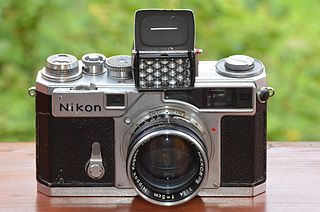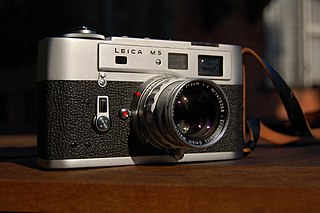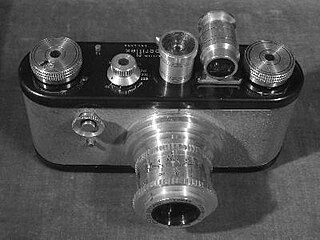Robot was a German imaging company known originally for clockwork cameras, later producing surveillance (Traffipax) and bank security cameras. Originally created in 1934 as a brand of Otto Berning, it became part of the Jenoptik group of optical companies in 1999, and specializes in traffic surveillance today.

Zorki is the name of a series of 35mm rangefinder cameras manufactured in the Soviet Union between 1948 and 1978.
Kiev is a Soviet and Ukrainian brand of photographic equipment including cameras manufactured by the Arsenal Factory in Kiev, Ukraine. The camera nameplates show the name "KIEV", with older cameras using "КИЕВ" or "КИЇВ" in Cyrillic.

The Argus C3 was a low-priced rangefinder camera mass-produced from 1939 to 1966 by Argus in Ann Arbor, Michigan, United States. The camera sold over 2.2 million units, making it one of the most popular American cameras in history. Due to its shape, size, and weight, it is commonly referred to as "The Brick" by photographers. The most famous 20th-century photographer who used it was Tony Vaccaro, who employed this model during World War II.

Retina was the brand-name of a long-running series of German-built Kodak 35mm cameras, produced from 1934 until 1969. Kodak Retina cameras were manufactured in Stuttgart-Wangen by the Kodak AG Dr. Nagel Werk which Kodak had acquired in December 1931.

The Rollei 35 is a 35mm miniature viewfinder camera built by Rollei. The original Rollei 35, when introduced at photokina in 1966, was the smallest existing 135 film camera. The Rollei 35 series remains one of the smallest 35 mm cameras after the Minolta TC-1 and Minox 35. In 30 years, about 2 million Rollei 35 series cameras were manufactured. The Rollei 35 was manufactured by DHW Fototechnik up to 2015, the successor of Franke & Heidecke as small-batch production. The last version is the Rollei 35 Classic, an updated Rollei 35 SE.

The Nikon SP is a professional level, interchangeable lens, 35 mm film, rangefinder camera introduced in 1957. It is the culmination of Nikon's rangefinder development which started in 1948 with the Nikon I, and was "arguably the most advanced rangefinder of its time." It was manufactured by the Japanese optics company Nippon Kogaku K. K.. Three other lower featured rangefinder models were subsequently produced on the SP frame, and production continued into the 1960s, but further development of Nikon's professional rangefinders ended with the introduction and success of the single lens reflex Nikon F in 1959.

The Konica Hexar RF is a 35 mm rangefinder camera which was sold by Konica. It was introduced to the market on 13 October 1999. and subsequently discontinued some time before the end of 2003. The camera used the "Bayonet Konica KM-mount", a copy of the Leica M-mount, thus sharing interchangeable lenses with those designed for Leica cameras and others compatible with them. The Hexar RF has a combined rangefinder/viewfinder modeled on that of Leica cameras, a similar body shape and size - and so is similar to Leica M-mount cameras in many aspects of operation.

The Konica Hexar is a 35 mm fixed-lens, fixed focal length autofocus camera which was produced through the 1990s. It was introduced to the market in 1993. While styled like a rangefinder camera, and intended for a similar style of photography, in specification it is more like a larger "point and shoot" camera.

The Bessa family of cameras was manufactured in Japan by Cosina as a revival of the Voigtländer brand name.

The FED 2 was a 35 mm rangefinder camera introduced in 1955 by FED. The name of FED comes from the initial of Felix Edmundovich Dzerzhinsky.

The Leica M5 is a 35 mm camera by Leica Camera AG, introduced in 1971. It was the first Leica rangefinder camera to feature through-the-lens (TTL) metering and the last to be made entirely in Wetzlar by hand using the traditional "adjust and fit" method.

The Kodak Retina Reflex is a discontinued series of four single-lens reflex cameras made by Kodak, continuing the brand Kodak Retina.

The Mecaflex is a 35mm SLR camera for 50 exposures of 24 × 24 mm. It was presented at the photokina in Cologne in 1951, and launched commercially about two years later. The design is by Heinz Kilfitt, who is also known for designing the original Robot camera and the Kowa Six.

The Kodak Stereo Camera was a 35mm film stereo camera produced between 1954 and 1959. Similar to the Stereo Realist, the camera employed two lenses to take twin shots of scenes, which could then be viewed in dedicated image viewers. The lenses supported adjustable apertures and variable shutter speeds. The camera had a reputation for being easy to use, and sold approximately 100,000 units during the time it was produced.

The Periflex 35mm camera was launched by K. G. Corfield Ltd, England in May 1953 as the first and original model from this source. The camera resembles the Leica Standard and qualifies fully as a Leica copy. However, film loading is by way of a removable back, and it provides through the lens visual focusing using an inverted periscope to be lowered into the light path between the lens and the film, utilising the single-lens reflex principle, showing a small section from the lower middle of the full image. The Periflex became quite popular in Britain and several improved models were introduced during the ensuing years until their demise in the early 1960s.

The Kodak 35 Rangefinder is an improved version of the Kodak 35 that was launched by the Eastman Kodak Company in 1938 as their first 35mm camera manufactured in the USA. After some two years, the Company presented this improved Kodak 35 camera, with a new superstructure housing containing a viewfinder and a separate rangefinder, but without any addition to the identifying inscription on the body. It is generally referred to as the Kodak 35 Rangefinder model.

The Minolta-35 was launched in the spring of 1947 by Chiyoda Kogaku. It was the first successful new 35mm rangefinder camera with Leica specifications to emerge on the market after World War II that uses the 39mm screw lens-mount. The Minolta-35 range of cameras was manufactured in quantities during its twelve-year production period, totalling about 40,000 units. Only the 1933 FED and the 1940 Leotax cameras had appeared successfully before it, although several Leica copies had appeared in both Italy and Japan.

The Kine Exakta was the first 35mm single-lens reflex (SLR) still camera in regular production. It was presented by Ihagee Kamerawerk Steenbergen GmbH, Dresden at the Leipziger Frühjahrsmesse in March 1936. The Exakta name had already been used by Ihagee on a roll film rangefinder RF camera line since 1933, among these the Vest Pocket Exakta Model B from which the Kine Exakta inherited its general layout and appearance. The word Kine never appeared on the camera itself, only in the instruction manuals and advertising to distinguish it from the roll film variants. Several of its features constituted the foundation for the majority of 35mm SLR cameras produced ever since, although at this stage in a relatively primitive state.

Kamera-Werkstätten Guthe & Thorsch (K.W.) was established 1919 in Dresden by Paul Guthe and Benno Thorsch, starting out manufacturing the Patent Etui plate camera. Ten years later came the roll film TLR Pilot Reflex and in 1936, the 6×6 SLR Pilot range. By that time, Benno Thorsch, the surviving partner from 1919, decided to immigrate to the United States and arranged with the US citizen Charles Noble to swap enterprises. Noble came to Germany and moved the factory to Niedersedlitz on the outskirts of Dresden, while Benno Thorsch in Detroit ran the acquired photo finishing business that was one of the largest in the USA. The new Kamera-Werkstätten AG, Niedersedlitz prospered, and in 1939 launched the 35mm SLR Praktiflex camera. The concept proved successful, and through continuous development, the Praktica name became one of the most popular 35mm SLR brands for several decades, beginning in the 1950s.


















